Physical Address
304 North Cardinal St.
Dorchester Center, MA 02124
The goals of blepharoplasty and brow-lift are to restore the youthful appearance of the eyelid–eyebrow unit with a perfect functional result and optimal facial aesthetic appeal.
Today's aesthetic eyelid surgery rejuvenates by contouring and repositioning the orbital fat, restoring the convexity of the lid–brow junction, and elevating the brow whenever brow ptosis is present.
Profound knowledge of the anatomy and all operating procedures necessary to rejuvenate the orbital unit, as well as appropriate preoperative evaluation, enhances the likelihood of a perfect outcome.
Upper and lower eyelid blepharoplasty can be performed as distinct procedures or can be combined in the same surgical setting. Brow-lift can be performed concomitantly, if necessary. If blepharoplasty and brow-lift are to be combined, first brow-lift should be performed and then the upper eyelid skin excision should be reevaluated in order to prevent removal of excessive skin.
Blepharoplasty and brow-lift should be customized to the individual patient to achieve maximum aesthetic improvement over the long term.
Aesthetic surgery of the orbital unit is neither simple nor should it be construed as only skin excision.
The advantages of using the laser beam of the UltraPulse ® Encore™ CO 2 (UPCO 2 ) laser (Lumenis Ltd, Yokneam, Israel) for laser-assisted blepharoplasty are: minimal intraoperative bleeding with improved recognition of the eyelid anatomy, shorter operating time, and reduced postoperative bruising and swelling. Laser-assisted blepharoplasty requires intravenous sedation or general anesthesia.
The Asian double-eyelid procedure, also referred to as lid-crease procedure, is a surgical technique that is increasingly in demand among native Far East Asians rather than among American- or European-Asians. Therefore, the Waikiki partial-incision technique is presented in this chapter as an alternative method to be offered to the younger patient.
Blepharoplasty and brow-lift are popular aesthetic surgical procedures performed by surgeons specializing in: dermatologic, oculoplastic, otorhinolaryngologic, maxillofacial, general, and plastic surgery. The goal of this chapter is to provide the reader with a thorough understanding of the surgical anatomy and principles involved with eyelid and eyebrow surgery. Both the aesthetic and functional aspects of eyelid surgery should be taken into consideration in order to restore a full visual field for the patient with extreme dermatochalasis. Excess upper eyelid skin may serve as a donor site for full-thickness skin grafts. While no single standard or cookbook approach exists for any surgical procedure, certain concepts and techniques have withstood the test of time and are generally accepted.
Blepharoplasty (Greek blepharon , meaning eyelid, and plastos , meaning created) has a more than 1000-year-old history. Aesthetic eyelid surgery is the result of a continuous development and refinement of surgical techniques and instruments regarding excision of skin, degenerated muscles, herniated orbital fat, and creation of the upper eyelid crease, as well as restoring the supporting structural deficiencies.
Publications in Germany in the late 1800s surfaced regarding the excess fold of the upper eyelid. Fuchs was the first to point out the significance of the weakening of the levator aponeurosis in the metamorphosis of the excessive skin. Many view Fuchs as the first to correctly evaluate the recreation of the eyelid crease and recognize its aesthetic value. Fox was the first to utilize the word dermatochalasis in 1952 to accurately associate excess eyelid skin with aging.
Aesthetic eyelid surgery began its main and most important development at the beginning of the twentieth century in the USA, with Miller's publication of the first photograph to show the crescent-shaped incision for eliminating excessive lower eyelid skin. In 1924, Bourguet described the transconjunctival removal of herniated orbital fat in lower eyelid blepharoplasty and, 5 years later, the two separate fat pockets of the upper lid, which he recommended excising. In 1931, Joseph recognized the benefits of correcting brow ptosis for aesthetic reasons and described hairline and forehead crease incisions to elevate the brows. In 1961, Pang, who came from the Far East, promoted the supratarsal fixation, while Sheen introduced this terminology in 1974 to the West. In 1982, the Putterman textbook on cosmetic oculoplastic surgery described the full-thickness resection at the margin of the lower eyelid along with upper eyelid blepharoplasty.
The role of the UPCO 2 laser as a superior incisional instrument to perform blepharoplasty was first demonstrated by Baker in 1983, and published 1 year later in the Yearbook of Ophthalmology . The dermatologist Lawrence David was the first to use the UPCO 2 laser for transconjunctival blepharoplasty. There is no doubt today, despite much controversy, that laser-assisted blepharoplasty of the lower eyelids transconjunctivally in combination with laser skin resurfacing (LSR) of the periorbital skin is the state-of-the-art technique in aesthetic eyelid rejuvenation.
The aims of blepharoplasty in Asian patients are to create a double eyelid and accurately perform a medial epicanthoplasty without “westernization” of the Asian eye. In creation of the double eyelid, first, non-incision techniques were publicized by Mikamo and Uchida. The incision technique was first published by Maruo in 1929 in Japan, followed by other publications of Asian and Western eyelid surgeons, and finally was promoted as the standard operation by Fernandes and Flowers from Hawaii, which it remains to this day. The second author (YKK) modified the classical incision technique and developed the Waikiki partial-incision technique, as the method of choice to be selected for younger patients without skin redundancy.
The eyelid skin lies on a thin layer of subcutaneous tissue over the orbicularis oculi muscle ( Fig. 40.1 ). This orbicularis oculi muscle (OOM), innervated by the temporal branch of the facial nerve in the upper eyelid and by the zygomatic and buccal branches of the facial nerve in the lower eyelid ( Fig. 40.2 ), is divided into three regions: the pretarsal, the preseptal (the palpebral portion), and the orbital portion. Originating at the medial canthus, the orbital portion closes the eyes together with the palpebral portion.
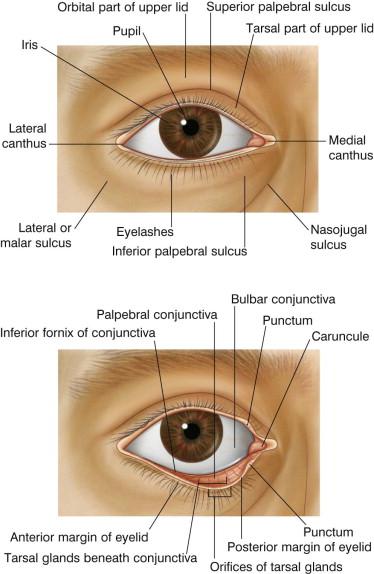
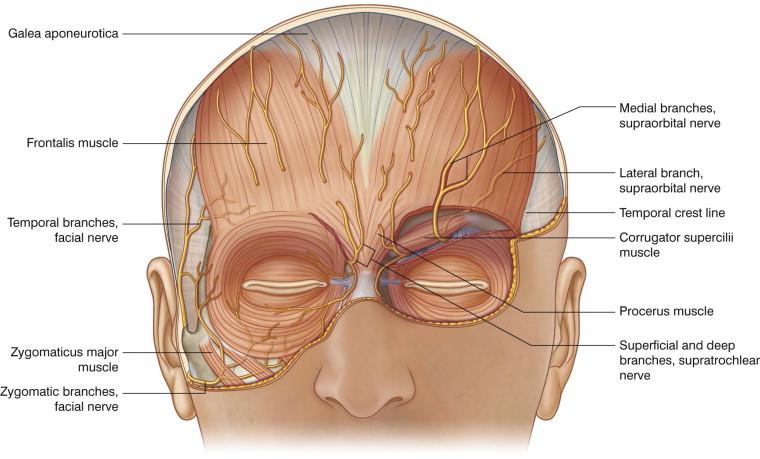
Under the OOM, the retro-orbicularis oculi fat (ROOF) in the upper eyelid and the suborbicularis oculi fat (SOOF) in the lower eyelid connect at their lateral ends overlying the orbital rim, lateral to the canthal tendon. The ROOF and SOOF are separated from the orbital fat pads by the orbital septum and, in the lower lid, also by the orbitomalar ligament, the so-called orbicularis retaining ligament. The ROOF lies between the anterior and posterior layers of the deep galea aponeurotica and, with age, it may hypertrophy, causing fullness in the brow and lateral half of the upper lid ( Fig. 40.3 ). Beneath the palpebral orbicularis muscle lies the orbital septum, dividing the orbit into an anterior and posterior compartment. On the upper eyelid, the orbital septum extends from the periosteum of the orbital rim (arcus marginalis) down to the levator aponeurosis. In the lower eyelid, the orbital septum joins the capsulopalpebral fascia. On the upper as well as on the lower eyelid, the septum does not reach the proximal border of the tarsal plate but fuses with the upper and lower lid retractors, 2–4 mm from the tarsal plate. In the Asian upper eyelid the septum fuses with the levator aponeurosis below the proximal border of the tarsal plate, and the levator aponeurosis does not penetrate the pretarsal OOM to insert into the dermis, which accounts for the creaseless aspect of the Asian upper eyelid as well as for the puffiness due to the descent of the preaponeurotic fat pad more inferiorly than in the non-Hispanic white upper eyelid ( Fig. 40.4 ). Flowers questions lid-crease formation due to levator aponeurosis insertion into the dermis and advocates lid-crease formation at the lowest point of the septo-aponeurotic sling's descent into the lid.
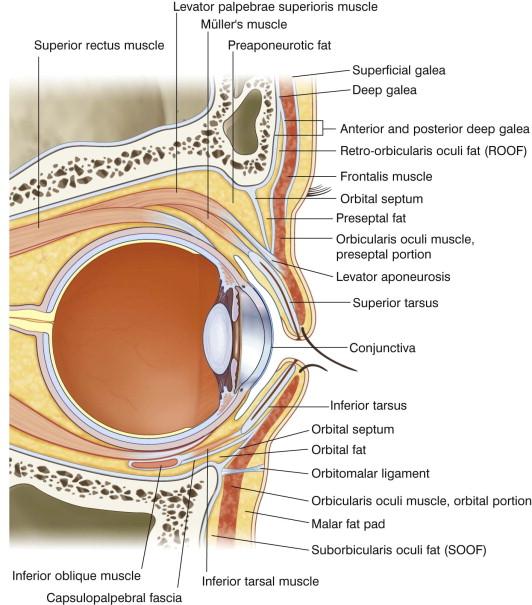
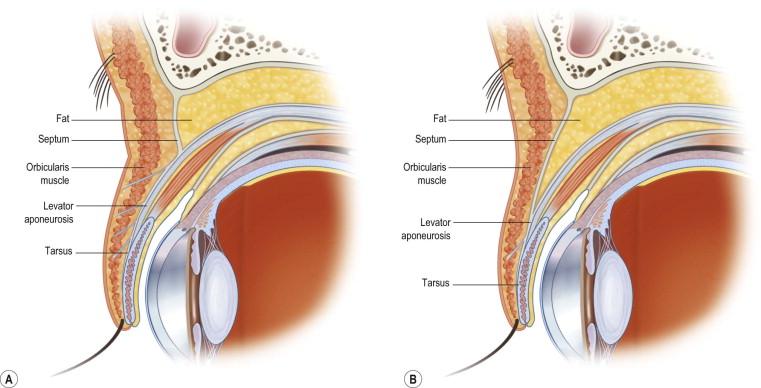
In the upper eyelid, there are two fat pads, a smaller medial one (white in color) and a larger central one (more yellow). Lateral to this preaponeurotic fat lies the lacrimal gland, in the lacrimal fossa. In the lower lid, the fat pads divide into three compartments: medial, central, and lateral. Between the medial and the central fat pads in the lower eyelid lies the inferior oblique muscle, which should not be damaged during fat pad reduction at the time of blepharoplasty. Figure 40.5 shows the locations of the fat pads that are frequently reduced during cosmetic blepharoplasty, as well as the canthal tendons and inferior oblique muscle.
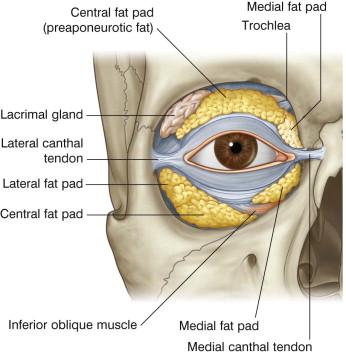
The levator palpebrae superioris muscle runs in a horizontal direction anteriorly in the orbit and changes at the Whitnall's ligament level to a vertical direction, the so-called levator aponeurosis. The fibers of the Whitnall's ligament connect to the trochlea medially, and laterally they extend to join the capsule of the lacrimal gland and finally insert at Whitnall's tubercle. The levator aponeurosis divides the lacrimal gland into a palpebral and an orbital lobe ( Fig. 40.6 ). The arterial supply to the eyelids and the venous drainage illustrated in Figure 40.7 should also be noted and avoided in eyelid surgery.
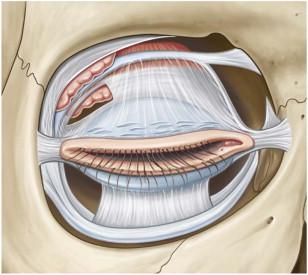
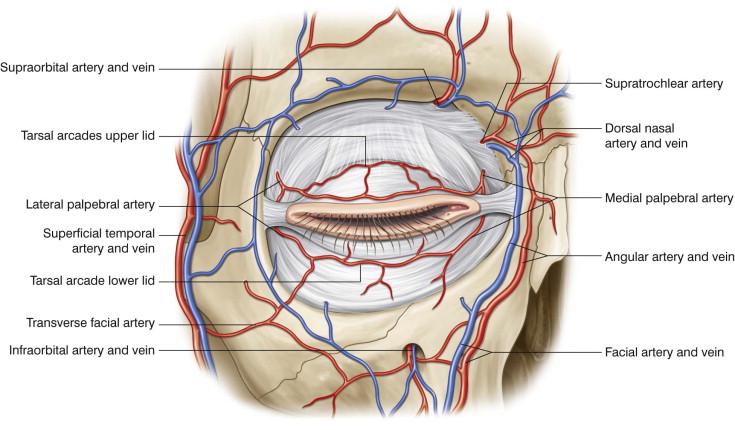
Patients seek out a surgeon desiring either a cosmetic enhancement or a functional improvement in their eyelids and/or brow region. The preoperative evaluation should include a thorough discussion of the risks and benefits of the planned procedure. Choose patients with realistic expectations and thoroughly evaluate them preoperatively, while also referring them to an ophthalmologist for a visual acuity examination and to exclude any eye disorders. When interviewing and evaluating patients, it may be best to use open-ended questions such as, “What do you wish to improve?” This interview process is optimized when patients contemplate and articulate their own goals for surgery. Ask patients to bring old photographs; these may help the surgeon determine what they want the postoperative result to resemble. A hand-held mirror allows patients to look at their face as a cotton-tipped applicator is used to hold up excess skin. The surgeon should be wary of the patient who asks what should be done. The surgeon may advise what can be done with an acceptable probability of success. Ultimately, patients must decide if what is possible is congruent with their aesthetic goals.
After the patient's goals for surgery have been clarified, the obligation of the surgeon is to thoroughly evaluate the patient. A safe procedure is recommended, and the patient is informed about additional procedures, which may be necessary.
Tests for lower lid laxity are paramount in the preoperative evaluation because scleral show or frank ectropion are possible side-effects after lower lid blepharoplasty. Two tests that should be routinely performed are the distraction test and the snap-back test. The distraction test, or so-called pinch test, is performed by pulling the lower lid anteriorly away from the globe. If greater than 7–8 mm of lid excursion occurs, lower lid horizontal laxity is present. In the snap-back test, the lower lid is pulled inferiorly and the patient is asked not to blink. If the lid does not spontaneously return to the normal position within 3 seconds, the test is positive, indicating lower lid laxity. If it returns only after the next blink, a severe lower lid laxity is present. The lower lid laxity is due mainly to laxity in one or both canthal tendons, alone or in combination with laxity in the orbicularis muscle. Lower lid laxity and/or lateral canthal tendon laxity are not contraindications to surgery, but rather an indication that a lid-tightening procedure may be needed (lower eyelid horizontal shortening resection or tarsal strip procedure, or a lateral canthal tendon tuck procedure, canthopexy, or canthoplasty). Figure 40.8 illustrates the snap-back and distraction tests. Lower scleral show may also be an indication of lower lid laxity.
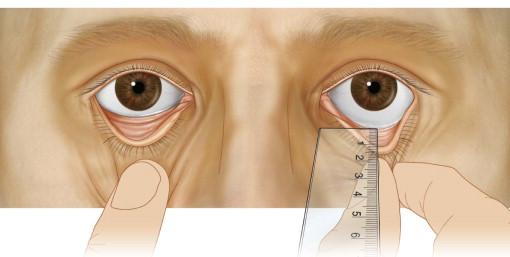
A patient with significant lid ptosis (blepharoptosis) will not be well served if only a blepharoplasty is performed and the underlying ptotic lid is not addressed. In a patient with significant dermatochalasis and mild ptosis (check to differentiate from pseudoptosis), simply pointing out the drooping of the eyelid preoperatively will be important. The preferred test for ptosis is measurement of the margin reflex distance (MRD). The upper MRD is a quantitative measurement of ptosis and represents the distance from the light reflex on the patient's cornea to the central upper eyelid margin with the patient's eyes in the primary position of gaze. Normal is 4–4.5 mm and is a positive number. Mild ptosis is manifested by an upper MRD of 1.5–2 mm; moderate ptosis by an MRD of 0.5 mm; and severe ptosis by an MRD of −0.5 mm. Figure 40.9 illustrates the upper and lower MRD and palpebral fissure measurements. If the ptosis is very accentuated and the upper eyelid covers the corneal reflex, the eyelid is raised until the reflex is seen and the distance is recorded in negative numbers. While an exact measurement is not necessary, it is important to note the distance from the corneal light reflex to the lower eyelid margin (lower MRD). It should be symmetric between the eyelids and may be an indication of globe malposition if asymmetric. The patient with globe malposition should be evaluated by an ophthalmologist as this condition may be associated with an orbital tumor or thyroid ophthalmopathy. Analyzing the globe position in relation to the orbital rim from a lateral view, a positive vector relationship between the most prominent point on the cornea, the lower lid margin and the malar eminence, is a normal and favorable anatomic situation. On the other hand, a negative vector relationship indicates a higher risk of lower eyelid retraction and scleral show, when performing additional LSR for rejuvenating wrinkled, sun-damaged skin.
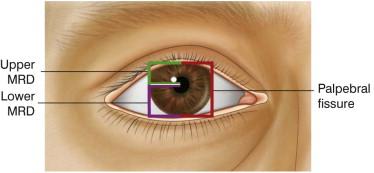
An assessment of levator function is also required. Measuring upper eyelid excursion when the patient moves the eyes from maximal down gaze to maximal up gaze with a fixed brow position can test levator function. A full discussion of the evaluation and management of ptosis may be found in various references. The blepharoplasty surgeon should be familiar with the etiology of adult ptosis and, if not an ophthalmologist himself, should consider consultation from an ophthalmologist. Figure 40.10 summarizes the most important examinations to be performed by an ophthalmologist before a blepharoplasty is carried out. The amount of ptosis and the function of the levator aponeurosis are key factors in determining the usual causes of ptosis and in choosing the appropriate operation (levator aponeurosis repair or levator resection).
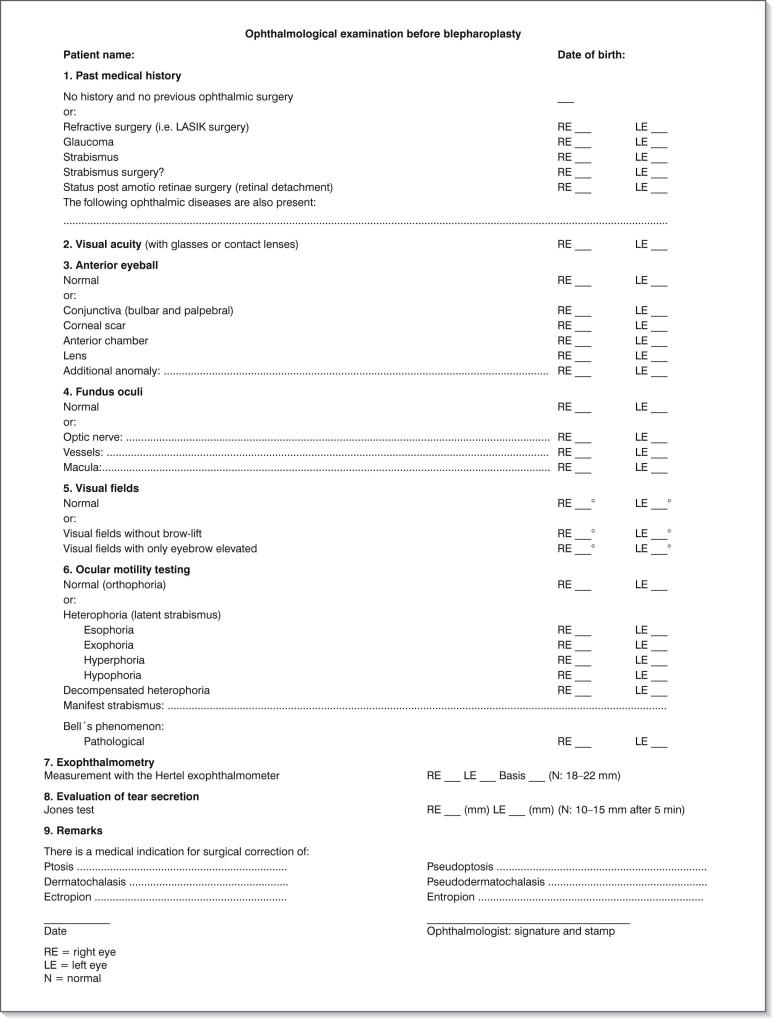
A pseudoptosis means a lowered upper eyelid margin caused by a huge amount of skin, degenerated muscle and increased fat pads pressing on the upper eyelid (levator function is normal) and can be improved by simply performing blepharoplasty. When analyzing the upper eyelid, the surgeon should differentiate between skin laxity alone or in combination with prolapsed preaponeurotic fat pads, prolapsed lacrimal glands, hypertrophy and descent of the ROOF, brow ptosis, and deficiency of the levator aponeurosis. If excess lower eyelid skin (so-called festoons) dominates the eyelid's pathology, fat pad removal transconjunctivally may be unnecessary in this patient. Such a patient is best served when both the upper and lower eyelids are operated on together. The excision of a significant amount of lower eyelid skin, in combination with lower lid laxity, requires a transcutaneous skin–muscle flap reduction with a small OOM flap anchored to the orbital rim of the upper eyelid.
It is helpful to develop a standardized preoperative evaluation template ( Fig. 40.11 ). The use of the template requires the surgeon to demonstrate conscious consideration of each aspect of the evaluation and to avoid omissions.
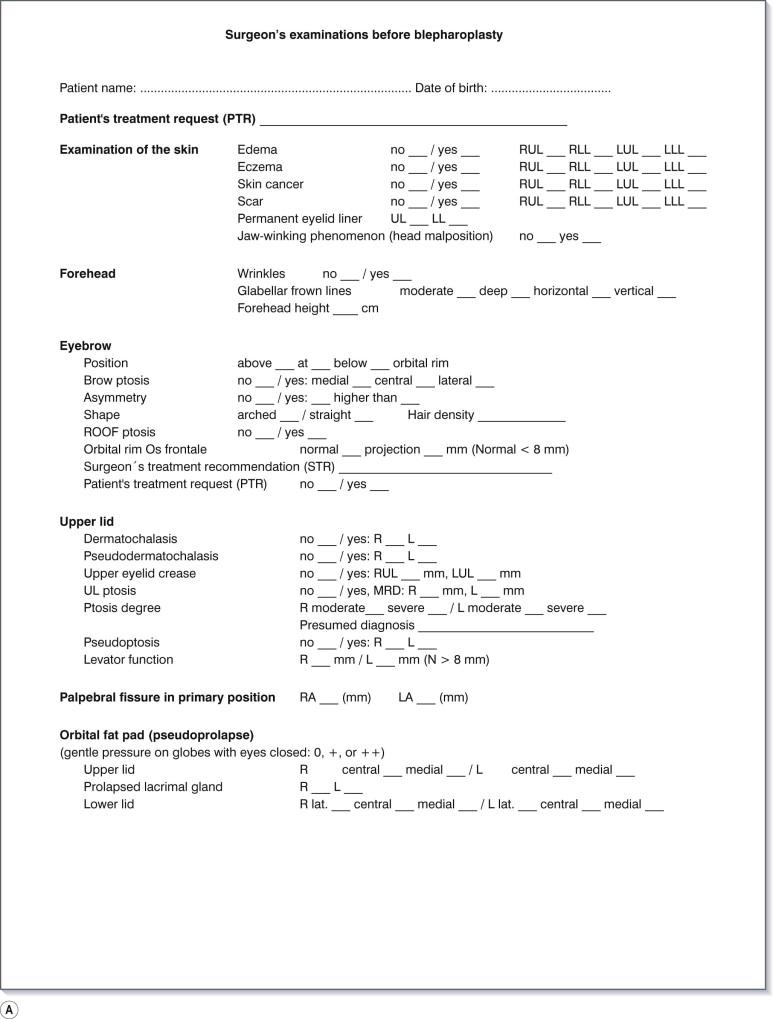
Particular attention is paid to signs or symptoms of thyroid ophthalmopathy, dry eyes (Jones test), previous ophthalmic surgery (wait at least 6 months after LASIK surgery or, if the patient plans to have LASIK, it is best to recommend having blepharoplasty first), recurrent eyelid and periorbital edema, allergies, sensitive skin, history of poor hearing, and keloid formation or hyperpigmentation.
Standard laboratory evaluation includes hematologic and coagulation profiles (complete blood count with platelets, prothrombin and partial thromboplastin times), a blood chemistry profile, and a thyroid panel. As discussed later, bleeding is a rare but serious complication of blepharoplasty. All anticoagulants must be stopped prior to surgery. If a patient has a medical condition that requires uninterrupted anticoagulants, proceeding with surgery should be seriously reconsidered. Herbal supplements and some vitamins may increase the tendency for bleeding and many common over-the-counter medications contain aspirin or non-steroidal anti-inflammatory drugs, as well as vitamin E. Blepharoplasty surgeons should maintain an updated list of such products. Blood pressure under good control helps to minimize bleeding complications. Using the UPCO 2 laser beam as a cutting tool, the risk of bleeding can also be reduced.
The shape and configuration of the eyebrows and the eyelid–eyebrow complex, as well as the fullness of the ROOF, should always be analyzed before surgery. Special attention should be paid to the brow position in relationship to the orbital rim. The male brow typically is relatively flat and rests at the level of the orbital rim. The female brow will generally arch laterally with its apex at the lateral canthus. As age-related changes occur, the position of the brow will descend, causing pseudodermatochalasis. Frequently, patients with marked pseudodermatochalasis asking for blepharoplasty need, in fact, a brow-lift. Patients unconsciously contract the frontalis muscle to overcome brow ptosis, thus forming deep forehead wrinkles. This phenomenon should be recognized and explained to the patient. First, the hyperkinetic and hypertonic frontalis muscle is treated with botulinum toxin A and, 2 weeks later, a brow-lift should be carried out. If necessary, an upper eyelid blepharoplasty can be done simultaneously; but best, should be considered as a later procedure.
If the operative plan includes general anesthesia or significant sedation, for example, when performing laser-assisted blepharoplasty (L-aB), an assessment of the patient's overall health must be taken into consideration. L-aB in combination with traditional LSR (TLSR) of the periorbital skin may be combined with fractional LSR (FLSR) of the entire face to avoid demarcation lines or significant differences between resurfaced and non-resurfaced facial skin.
Since a brow-lift – if necessary – should be performed first, we need to initially describe various brow-lift procedures. Brow-lift, while less commonly performed than blepharoplasty, is an important functional and cosmetic surgical procedure. Brow management is critical in a comprehensive approach to upper-face rejuvenation. The techniques range from minimally invasive office-based procedures to highly invasive surgery requiring general anesthesia. We will focus our discussion on traditional brow-lift operations, with a brief discussion of the newer techniques.
Browpexy, browplasty, direct brow-lift, bilateral mid-forehead brow-lift, mid-forehead lift, modified pretrichial forehead lift, and temporo-frontal brow-lift are valuable techniques for the properly selected patient. Figure 40.12 illustrates the traditional approaches to brow-lift. These techniques are, in essence, excisional surgeries.
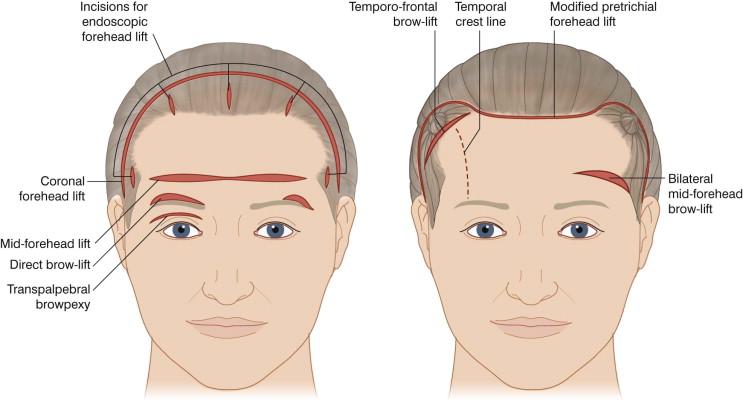
A transpalpebral browpexy (transblepharoplasty brow-lift/internal brow suspension) should be considered when a minimal brow-lift is required (approx. 0.5 cm), for example, in men and young women with a thick eyelid–eyebrow region and a lateral brow ptosis ( Fig. 40.13 ). The introduction of endoscopic brow-lift has reduced the emphasis placed on browpexy. However, the direct approach can be highly successful and should not be ignored. Its main advantage is that it requires no additional scarring and can be performed with local anesthesia during the blepharoplasty procedure. Tyers and Collin recommend cutting the ROOF (browplasty), leaving the periosteum intact. We recommend dissecting and undermining the lateral third of the forehead region supraperiosteally, in the glide plane space between the two layers of the deep galea, for a more effective brow-lift, because the postero-cephalic advancement of the skin–muscle-galea flap of the forehead will also eliminate the risk of forehead wrinkle formation above the eyebrow. For under-brow fixation, we recommend absorbable suture material. If asymmetry of the eyebrow position becomes a concern after surgery, massaging the more highly located eyebrow downwards along with using absorbable sutures will help restore brow symmetry.
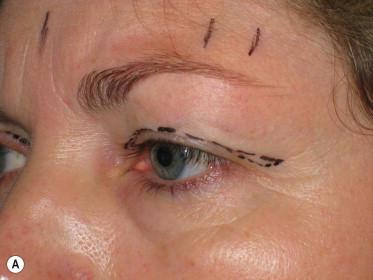
Direct brow-lift is the simplest and most direct approach performed only with local anesthesia and can be considered if asymmetries in brow position exist. Due to visible scars, the authors recommend using this procedure only in older patients ( Fig. 40.14 ).
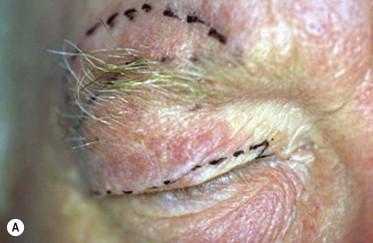
Bilateral mid-forehead brow-lift may also be considered when brow asymmetries are present (see ). Ideal candidates for this procedure are male or female patients with deep forehead lines and high foreheads. Perfectly placed incisions in forehead creases and accurate suturing techniques are mandatory to avoid visible scars ( Fig. 40.15 ). First, the excess skin is removed using a plane of dissection in the subcutaneous tissue. The first author (AF) recommends spreading the frontalis fibers and moving the skin–muscle flap upwards using a dissection plane under the deep galea for a longer-lasting effect. Using the Ramirez no.4 and no.7 dissectors, a release of the orbitomalar ligament at the supraorbital rim will help move the flap upwards. The wound closure will not be under any tension, and the risk of dehiscence scars is minimized. As with any surgical dissection, the surgeon should bear in mind the location of important nerves, for example the medial (superficial) and lateral (deep) branches of the supraorbital nerve.
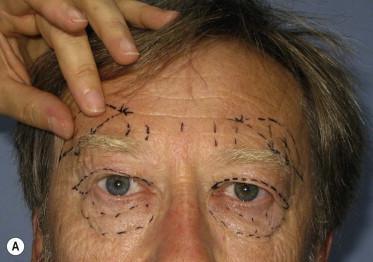
Temporo-frontal brow-lift can be employed if there is more lateral brow ptosis with accentuated crow's feet in patients with relatively narrow temples. Tyers and Collin prefer to remove an ellipse of skin and muscle based on a lateral forehead skin crease. We consider the temporo-frontal brow-lift to be the method of choice for patients with pseudodermatochalasis who are returning for a second blepharoplasty ( Fig. 40.16 ) and perform this method with the help of the lighted retractor or an endoscope to protect the sentinel vein (the medial zygomaticotemporal vein). It can be done in combination with upper eyelid blepharoplasty if this is also necessary, but should always be performed first. We prefer the curvilinear incision, which is marked approximately 2 cm inside the temporo-frontal hairline and is placed 2 cm medial and 4 cm lateral to the temporal crest line (the so-called zone of adhesion). With a blunt dissection (Trepsat scissors or Ramirez no.4 dissector), the temporal pocket is undermined just superficial to the deep temporal fascia (DTF) and is carried inferomedially down to the orbital rim ( Fig. 40.17A ). The medial pocket is created by spreading the frontalis fibres, opening the deep galea and performing a subperiosteal dissection down to the supraorbital rim. After both pockets have been prepared, they are connected from lateral to medial (like an endoscopic brow-lift) using a periosteal elevator or scissor scopic to divide the zone of adhesion down to the supraorbital rim. Special care is taken not to damage the neurovascular bundle containing the deep branches of the supraorbital nerve and terminal branches of the anterior temporal artery and vein ( Fig. 40.17B ). For a more effective postero-cephalic advancement of the temporal flap, not only the zone of adhesion at the temporal crest line but also the orbitomalar ligament should be divided. The orbitomalar ligament (orbital retaining ligament) bridges the orbital rim alongside the arcus marginalis (from the temporal crest line, down along the pars ascendens of the zygomatic bone to the middle of the inferior orbital rim) with the overlying OOM and skin. Wound closure is accomplished with 3-0 polyglactin (Vicryl) buried subdermal suture to suspend the temporal flap to the DTF and relieve all tension from the wound's edges ( Fig. 40.17C ). If the desired lifting effect is not accomplished, an additional lifting of the eyebrow is accomplished using a thread running through a buttonhole incision at the apex of the eyebrow then coming back and suturing to the deep galea. The wound closure is completed with stainless steel skin clips and a pressure dressing is applied.
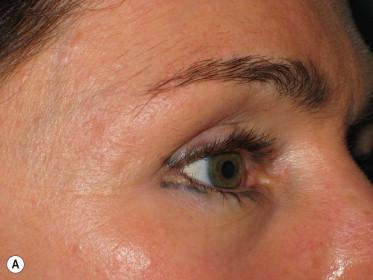
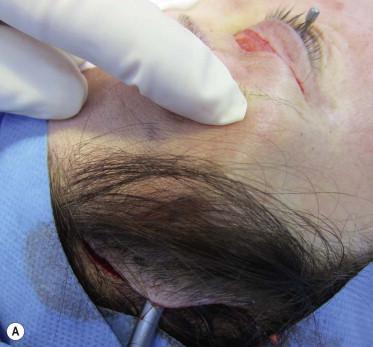
Mid-forehead lift is very similar to bilateral mid-forehead brow-lift. The difference is that the incision runs continuously within a prominent horizontal forehead crease.
A detailed description of forehead lift procedures (modified pretrichial forehead lift, coronal forehead lift, endoscopic forehead lift) is beyond the scope of this chapter and can be read in the cited sources.
The fundamental purpose of upper eyelid blepharoplasty is to remove redundant skin and muscle from the upper eyelid, along with or without variable amounts of fat.
The upper eyelid crease is marked, preferably by a series of dots: in women approximately 8–10 mm above the lash line and 10–15 mm below the eyebrow; in men 6–8 mm above the lash line and 10 mm below the eyebrow ( Fig. 40.18 ). After marking, the patient should assume an upright position to re-check the surgical markings. Pinch testing the planned resection with non-toothed forceps helps ensure an appropriate surgical plan, leaving enough skin to allow complete eyelid closure. The amount of skin removed must be customized for each patient and should be conservatively done to avoid lagophthalmos. The goal of surgery is to create a symmetric result, even if an asymmetric removal of skin, muscle, and/or fat is needed. Concomitant brow-lift will require a more conservative skin excision.
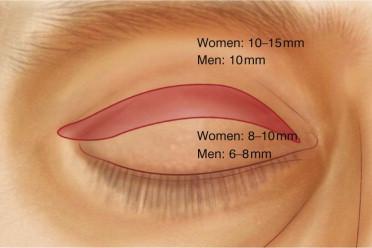
Become a Clinical Tree membership for Full access and enjoy Unlimited articles
If you are a member. Log in here